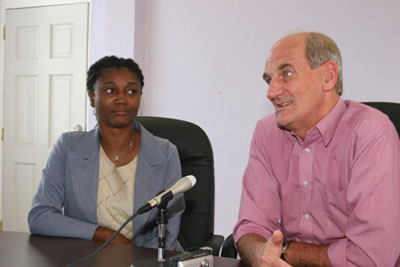 |
|
(L-R) Ms. Lilith Richards Director of Physical Planning, Natural Resources and Environment in Nevis and Mr. Geoff Webber Planning Consultant of Hyder Consulting in England. |
CHARLESTOWN NEVIS (November 23, 2006) -- Preparation work for a Policy Development Plan for Nevis moved to a new level this week with a series of consultative meetings with the Nevis Island Administration (NIA) and other key stakeholders from November 23 to 28, 2006.
Ms Lilith Richards Director of Physical Planning and Natural Resources and Environment in the NIA, told the Government Information Service on Wednesday November 22, 2006, that consultant Mr. Jeff Webber of Hyder Consulting in England was on the island to conduct the meetings.
She said the consultations were important now that the proposed plan had moved into the area of policy development and land allocation.
"At this stage, it is important that consideration is given to the opinions and views of key groups so that emerging issues, policies and land allocations can be explained and discussed in order for the draft plan to receive maximum consensus and support.
"This enables the current position to be assessed, various issues and concerns to be raised particularly with regard to the future. As the Island Plan will be looking forward to 2021, it is likely to affect the majority of residents and businesses on the island," she said.
Work on the Physical Development Plan commenced at the end of 2005 and according to Ms Richards, the proposed Physical Development Plan when completed will lay out a framework through a policy approach for the evaluation of land development in Nevis for the next 15 years. She said at present there was no frame work for applications therefore land is used in an ad hock manner.
"The Plan will give us that opportunity to manage our land resource. The Department of Physical Planning deals with land and we have to see each application as the use of land and we have to know what we plan to do for the future," she said.~~adz:Right~~"
Meantime, Mr Webber indicated that a series of background papers had already been prepared and was being discussed by a steering group which would provide a framework to move the Plan forward.
"We have reached the stage of consultation with some stakeholders and heads of departments to tell them of my findings on the population in households and the implications that has for land use."
"I have started drafting some of the policies relating to agriculture, education and environmental protection and we are going to talk to people on those policies at this draft stage so that they have the chance of influencing them. It is very important as we said that they [stakeholders] sign up and buy into the plan and you can only do that by talking to people as you develop it."
"So the purpose of this visit is to pick up data of what has been going on over the last three months and then to talk about policies," he said.
According to Mr. Webber, one factor which would influence the plan is the population forecast for Nevis, based on the island's natural growth for the next 15 years and the issue of in and out migration.
~~adz:Left~~ "We have looked at in and out migration because that is going to be of significant impact on the island because you have reversed the trend of a few years ago when you had out migration and now you are attracting people. There are nationals returning and other people coming from other Caribbean islands there are second homes and villas being built by inward investors, therefore we had to look at that population in order to help us identify the land acquired for housing, for industry for jobs and for the development of tourism.
"We don't know what is going to happen tomorrow let alone 15 years. Your population is going to grow quite substantially and we predicted it's going to be around 16, 200 by 2021. When you turn that into the number of households required, that's going to be quite a dramatic number of new house holds because the size of households are getting smaller and so the quality of housing you are going to aspire to, it requires larger properties. Also there are more single house holds and all that puts pressure on. While your population is likely to grow by 40 percent, the demand for your households and houses will be about 60 percent so you can't just turn population into housing you have to take in trends and changes," Mr. Webber explained.